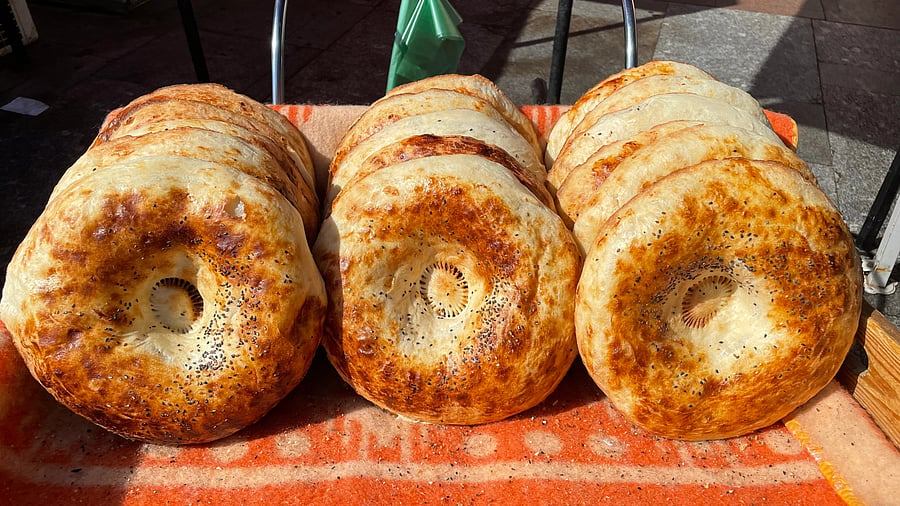
Credit: Author
The first thing I learned in Tashkent is that the city reveals its soul not in grand monuments, but in its markets. To wander through them is to step into a living storybook of the Silk Road, where spices whisper of caravans, bread carries blessings, and every stall feels like a stage set for hospitality. On my first morning in the Uzbek capital, I followed the aromas—smoke, yeast, spice—straight into the turquoise-domed Chorsu Bazaar, and found myself swept into the city’s edible heartbeat.
A feast for the senses
Inside, the air was thick with temptation. The nutty warmth of non (round bread) lifted fresh from clay tandoors mingled with the perfume of plov (pulao or the country’s national dish) simmering in massive kazan cauldrons. I drifted past stalls stacked with golden apricots, pomegranates bursting like rubies, and glistening slabs of amber honeycomb.
A woman in a scarlet ikat scarf caught my eye. Before I could ask, she pressed a steaming bowl of shurpa—lamb soup fragrant with herbs—into my hands. It tasted like a hug in a bowl! A few steps away, a man deftly folded pastry around a pumpkin filling handing me a sample. The crust flaked, the spice lingered, and suddenly I understood: here, food isn’t just sold. It’s shared, insisted upon, given as a gesture of friendship.
Stamp of the Silk Road
As I moved deeper into the bazaar, history trailed me like a shadow. This land was once the axis of the Silk Road, where Persians, Chinese, Arabs, and Indians traded not just goods but flavours. That lineage lives on in the market’s offerings: cumin and coriander, green tea bricks, saffron, dried fruits so sweet they seem candied by the desert sun.
At Alay Bazaar, one of Tashkent’s oldest, I lingered by a stall overflowing with Iranian pistachios, Afghan raisins, and Uzbek almonds. The vendor, an elderly woman with a face weathered like parchment, brewed me a glass of black tea on a charcoal stove. All for Rs 10! We conversed with half-words and hand gestures. I left with a bag of dried mulberries, and something richer: the sense that these bazaars remain cultural crossroads, alive with the hum of exchange! The beauty of these markets is overwhelming. Heaps of emerald cucumbers, pyramids of saffron-yellow melons, baskets of cherries glowing like drops of wine—it felt like walking through a painter’s palette.
But the bread displays stopped me in my tracks. Towers of non rose in golden stacks, each loaf stamped with intricate patterns. Bread here is sacred. It is never placed upside down; wasting it is unthinkable. One baker slid a bite of wedding non, thick and braided with sesame, into my bag. “For luck,” he said, his smile as warm as the oven behind him.
Food as theatre
There is performance in the markets too. Butchers, their knives flashing, carved lamb carcasses with practiced ease. Spice sellers scooped vivid powders into cones, their stalls perfumed like apothecaries. And then—plov. I joined a crowd encircling a plov master, his kazan big enough to bathe in. With a wooden paddle, he folded carrots, lamb, chickpeas, and garlic bulbs into a shimmering mound of rice. The air quivered with cumin, coriander, and barberries. When he finally served it, I ate standing, the grains buttery and spiced, the lamb tender, the raisins sweet as jewels. It was food elevated to ritual, theatre to taste.
Faces that stay with you
More than flavours, it was people who etched themselves into my memory. A melon seller who sliced open his finest galia (a melon variety) and insisted I taste. A spice merchant who scribbled a plov recipe in Cyrillic on scrap paper. Each gesture reminded me that these markets are about more than trade. They are about generosity, about weaving strangers into a community through food.
As I wandered, I realised the deeper layers of what I was tasting. Dried fruits weren’t just snacks—they were sustenance for caravans crossing deserts. Kurut, those tart dried yogurt balls, echoed nomadic traditions. Kaymak, rich and silky, spoke of pastoral abundance.
These markets are not relics of the past. They are living museums where tradition breathes in the present, where the rituals of bread, fruit, and spice tell stories as eloquently as any manuscript or monument. When I finally left, my arms were heavy with saffron, walnuts, and ceramics, but what stayed with me was far less tangible. The memory of bread warm from the oven. The laughter of a vendor teaching me to pronounce “barberry.” The way plov steam curled into the air like incense!
Even later, as the scent of baked non lingered on my clothes, I knew I had carried something more enduring than souvenirs back to India. In Tashkent, the markets are the city’s soul—living, generous, unforgettable—and to walk through them is to taste the Silk Road itself.